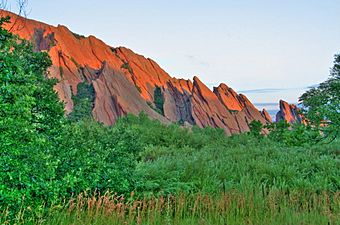Roxborough State Park Archaeological District facts for kids
The Roxborough State Park Archaeological District is a special place in Douglas County, Colorado. It's part of Roxborough State Park, which is about 25 miles (40 km) south of Denver, Colorado. This park is famous for its amazing red rock formations.
Long ago, ancient people lived or camped here. They were hunter-gatherers, meaning they hunted animals and collected plants for food. They also used stone from the area to make tools and even farmed. This area was added to the National Register of Historic Places in 1983 because of its important history.
Contents
Explore Roxborough State Park
The Archaeological District is inside the 3,299-acre Roxborough State Park. This park is well-known for its dramatic red sandstone rocks. In 1980, it was named a National Natural Landmark. This means it's a very important natural area because of its unique ecosystems and rock formations. It's also a State Historic Site and a National Cultural District due to its many archaeological sites.
Animals and Plants of Roxborough
Roxborough State Park has several different natural areas, called ecosystems. You can find forests with tall ponderosa pine and Douglas fir trees. There are also wide prairies and woodlands. These different areas are home to many kinds of wildlife.
The park is a great place for animal lovers! It has 145 types of birds and over 50 kinds of butterflies and moths. You might also spot 11 different amphibian and reptile species. Some common animals living here include black bears, coyotes, deer, elk, foxes, prairie dogs, and rabbits. Water sources like Little Willow Creek, Willow Creek, and Mill Gulch help these animals thrive. The park's elevation ranges from 5,900 to 7,280 feet (1,800 to 2,220 m).
Ancient History of the Denver Area
The Denver Basin is a large geological area that stretches from Colorado Springs up to Wyoming. Within this basin, scientists divide ancient times into three main periods. These are the Paleo-Indian, Archaic, and Woodland (or Ceramic) periods. The Palmer Divide is a high area within the Denver Basin. It separates the rivers that flow into the South Platte River from those that flow into the Arkansas River.
Paleo-Indian Period: Early Hunters
The Paleo-Indians lived here a very long time ago, from about 9550 BC to 5850 BC. They were mostly hunters of large animals, like the huge Bison antiquus. This was at the end of the Ice Age, when a lot of the land was covered by lakes and grassy plains called savannas. As the Ice Age ended, the land became drier, turning into a desert. People had to change how they lived to survive. This led to the next period, the Archaic period.
Archaic Period: Adapting to Change
During the Archaic time, from 5850 BC to 3050 BC, people hunted smaller animals. They hunted deer, antelope, and rabbits. They also gathered wild plants for food. These people moved from place to place with the seasons, following the best hunting and gathering spots. Later in this period, around 200-500 AD, people started growing corn. They also began making pottery to store their food.
Archaic people built structures using stone walls. The people living at Roxborough used two stone quarries in the park's Hogback region. They used these quarries to get stone for tools from the early Archaic period and beyond. Different quarries in Roxborough had various types of stone. These included jasper, opal, petrified wood, and quartzite.
Woodland Period: Settling Down
The groups of people during the Woodland period (500-1000 AD) became more settled. They were more likely to live in one or two main places. They started farming and raising animals. They also became skilled at making pottery and baskets. This period also saw more complex ceremonies and rituals.
What We Found: Archaeological Discoveries
The Colorado Archaeological Society did the first study in 1977. Another study happened in 2000 to learn more about known sites and explore new areas. On County Road 18, inside Roxborough State Park, there are 12 archaeological sites. These sites show where nomadic Paleo-Indians and other Native Americans lived. There are also some items from early European American settlers in the Stagecoach area.
Archaeological surveys show that people lived here during the Paleo-Indian, Archaic, and Woodland periods. Over time, their way of life changed. They went from mainly hunting bison to farming, making their own goods, trading, and developing a more complex society.
We know ancient people traded because of pieces of catlinite pipe found at Roxborough and another site called Franktown Cave. Catlinite stone comes from Minnesota, which is far away! Most of the items found were from the late Archaic and Woodland periods. People at Roxborough often lived in sheltered areas near water. They likely spent winters here, as they used shelters that faced south and west for warmth. The ancient people who lived or traveled through this land were ancestors to tribes like the Apache, Arapaho, Cheyenne, Comanche, and Ute. The Utes used the Stagecoach area for summer hunting. Their trails eventually became County Roads 14 and 18.


